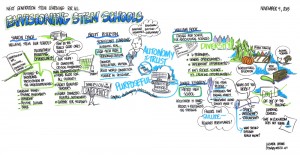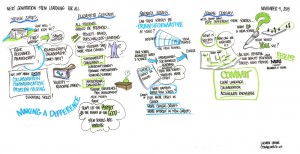More than 80 researchers and practitioners presented their work in panels and poster sessions. We include here a brief summary of each panel, speaker presentation materials, and the graphic recordings for those panels attended by the graphic recorder.
Opening Remarks
Joan Ferrini-Mundy, Assistant Director of the Directorate of Education and Human Resources at the National Science Foundation, introduced the NSF-supported science, technology, engineering, and math (STEM) Forum and challenged participants to engage across stakeholder groups to envision the next generation of STEM learning. Video:
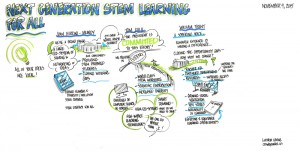
Tom Kalil, Deputy Director for Technology and Innovation at the Office of Science and Technology Policy, highlighted President Obama’s commitment to transforming high schools and promoting next generation STEM learning for all. Video:
William Trent, Professor of Education Policy, Organization and Leadership, and Sociology at the University of Illinois, Urbana, emphasized the importance of systemic change needed to broaden participation and better fit the needs of all students, particularly those most underrepresented in STEM. Video:
Plenary: Envisioning STEM Schools
During the plenary session, school leaders provided profiles of successful STEM schools and credited their success to strategies such as developing a strong curricula, dynamic assessments, responsive leadership, and support of student agency. Researchers reflected on implications of results of different studies related to expanding highly effective and inclusive STEM schools more broadly. Video:
Presenter Bios and Powerpoints
Sharon Lynch: bio | Opportunity Structures for Preparation and Inspiration (OSPrI): Case Studies
Brett Peterson: bio | High Tech High
William Hook: bio | Chicago High School for Agricultural Experiences
Aimee Kennedy: bio | Which Diplomas Matter
Steven Zipkes: bio | Advanced Reasoning in Education
Elizabeth Glennie: bio | Redesigned High Schools for Transformed STEM Learning
Barbara Means: bio | Expanding the STEM Education Funnel: Inclusive STEM-focused High Schools
Jeanne Century: bio | Identifying and Measuring STEM Schools and Programs
Concurrent Sessions I
Learning Across Contexts: Rethinking Time and Space for Teaching and Learning
Speakers shared various innovative approaches to STEM learning, including game-based learning and how it can be applied to teach and formatively assess complex skills; maker spaces and how they can increase student engagement in STEM; models of mentoring; and interdisciplinary approaches to STEM learning.
Presenter Bios and Powerpoints
Beth Warren: bio | ArtScience Designs for Learning That Matters
Brian Gravel: bio | Engineering Inquiry for All at Nedlam’s Workshop
Edward Price: bio | Making STEM Relevant In Underserved Communities
Jodi Asbell-Clarke: bio | The Power of Digital Games for the Next Generation of STEM Learning
Chad Milner: bio | The Young People’s Project
STEM Research Experiences for Teachers
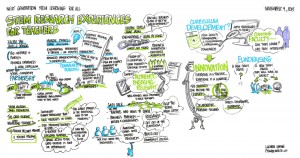
Four teacher-researcher teams, funded by NSF’s Research Experiences for Teachers program, described how collaboration between universities and schools can transform STEM learning experiences for K-12 students and inform both research and practice.
Presenter Bios and Powerpoints
Sarah Morgan: bio and James Brownlow: bio | Graduate Student Scientists in the Classroom
Gary Hales: bio
Margaret Pinnell: bio and Shane Sullivan: bio | NSF Research Experience for Teachers in Dayton, Ohio
Xiaobo Tan: bio and Janelle Orange: bio | Going Beyond Research Experiences for Teachers
Vikram Kapila: bio and Jigar Jadav: bio | Lessons from a Research Experience for Teachers Site
Cyberenabled, Collaborative Learning Environments: Rethinking Time and Space for STEM Teaching and Learning
Attendees learned about innovative learning technologies in the classroom, such as online collaborations, immersive 3D worlds in which students collect data and make observations in a virtual environment, virtual hotspots that allow students to chart and plot data, and macroworlds that transform classrooms into immersive environments such as earthquake simulations.
Presenter Bios and Powerpoints
Amy Kamarainen: bio | EcoMOBILE and EcoXPT: Real and Virtual Immersive Experiences for Learning Ecosystem Science
Cathie Norris: bio | WeCollabrify
Tom Moher: bio | Macroworlds
Denise Sekaquaptewa: bio | Stereotypic Roles and Microaggressions in Engineering Student Group Project Teams
Kathy Wright: bio | Experiential Learning in Science and Engineering Disciplines using Digital Backpacks
Peers, Mentors, and Messaging: Broadening Participation in STEM
Successful mentoring models were shared, including providing credit to college students who mentor high schoolers, developing “social vaccines” by pairing female students with female mentors at key transition points in their education, mentoring students virtually with those outside of the school setting, and sharing self-mentoring strategies with students.
Presenter Bios and Powerpoints
Nilanjana Dasgupta: bio | How “Social Vaccines” Can Diversify STEM
Barbara Schneider: bio | What is the College Ambition Program?
Rita Karl: bio | SciGirls
Noel Gregg: bio | Virtual Mentoring
Renetta Tull: bio | Beyond the Next Level … The Road to Nobel
Assistive Technologies for Learning: Broadening Participation in STEM
Innovative technologies developed to help students with disabilities can mitigate feelings of isolation, increase collaborative engagement, and increase access to experiences of hands-on, scientific pursuits. In addition, these technologies often benefit all students, not just those with disabilities, to access important learning opportunities.
Presenter Bios and Powerpoints
Jenna Gorlewicz: bio | Using “Touch” in Touchscreens for Teaching STEM to Blind and Visually Impaired Students
Ethan Danahy: bio | Creating Inclusive Learning through Collaborative Tools and Supports
Kathy Perkins: bio | PhET Interactive Simulations
Donna Lange: bio | DeafTEC
Richard Ladner: bio | Access CS 10K
Developing Tomorrow’s Cyber Workforce: Broadening Participation in STEM
Speakers shared the innovative efforts of their affiliated organizations to broaden participation in the cyber workforce, particularly the field of cybersecurity.
Presenter Bios and Powerpoints
Josh Pauli: bio | Cyber Workforce: Grades 6-20
Tony Coulson: bio | Cyber Security Center
Ambareen Siraj: bio | Broadening Participation in Cybersecurity
Poster, Demonstration and Networking Session
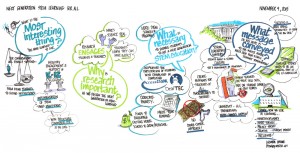
Forum presenters also shared their work during a poster session. See a list and map of the exhibitors.
During the poster hall, meeting participants were asked to respond to four questions: 1) What was the most interesting thing you have learned so far? 2) Why is research important as we design the next generation of STEM learning? 3) What is necessary to enable students to get a next generation STEM education? 4) What message do you hope is conveyed to the White House Next Generation High School Summit tomorrow?
Their responses were captured (see above image) by the graphic recorder.
Concurrent Sessions II
Instructional Materials for Ambitious STEM Teaching and Learning
Examples of instructional materials that enable all students to learn rigorous content, such as dynamic mathematical representations and engineering design principles, were shared.
Presenter Bios and Powerpoints
Jeremy Roschelle: bio | Dynamic Representations: Democratizing Access to Important Mathematics
Joseph Krajcik: bio | Developing and Testing a Model to Support Student Understanding of Sub-microscopic Interactions
Okhee Lee: bio | Promoting Science Among English Language Learners (P-SELL) Scale-Up
Tamara Moore: bio | Engineering as the STEM Integration Connection for All Learners
Alexander Repenning: bio | STEM Tools Crossing the Educational Chasm
Alfred Hall: bio | An Overview of the Memphis Virtual STEM Academy at East High School
Engaging Students in Authentic STEM Discovery and Innovation
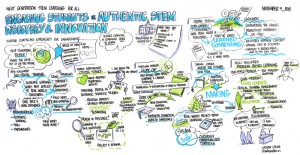
Various approaches for engaging students in authentic learning experiences were shared, including citizen mapping using geospatial technology; citizen science activities; classroom-industry partnerships; maker projects and spaces; problem-based learning to address real world challenges; and games that allow students to contribute to scientific discoveries.
Presenter Bios and Powerpoints
Beth Schlemper: bio | Advancing Geospatial Thinking and Technologies in Grades 9-12
Karen Oberhauser: bio | Driven to Discover
Svetlana Darche: bio | Globe CAP
Zoran Popovic: bio | Learning through Scientific Discovery
Shawn Jordan: bio | Empowering High School Students to Invent the Future with STEM
Kelli Vallieres: bio | Problem-based Learning and Student Centered Education
Schools as Part of Smart and Connected Communities
Within the context of NSF’s Dear Colleague letter that encourages innovative proposals for developing Smart and Connected Communities, speakers described how their work connects STEM learning with communities in need, how their work could shape schools of the future, and how to involve key systems and stakeholders in the development of these communities.
Presenter Bios and Powerpoints
Lauren Birney: bio | Curriculum and Community Enterprise for Restoration Science in New York Harbor
Leslie Rupert Herrenkohl: bio | STUDIO: Build Our World
Jan Mokros: bio | The STEM Guides Project
Carrie Tzou: bio | Schools as Smart & Connected Communities: Stakeholders
Brenda Bannan: bio | Can Smart Cities Contribute to STEM Learning and Workforce Development?
Mitchell Shears: bio | Smart & Connected Communities
Chris Lehmann: bio | Science Leadership Academy
Partnerships for Pathways to STEM Workforce
Presenters shared examples and research findings about pathways and experiences that support students’ career-and workplace-focused learning, develop their awareness of jobs and careers, and enable them to experience the challenges of real workplace settings.
Presenter Bios and Powerpoints
John Ristvey: bio | Partnerships for Pathways to STEM Workforce
Reed Stevens: bio | FUSE Studios
Karen Tingley: bio | Wildlife Conservation Society
Teresa Mourad: bio | Strategies for Ecology Education, Diversity and Sustainability (SEEDS)
Jacqueline Crisman: bio | Helping Future Biotechnologists in Rural Appalachia HURI-up with Undergraduate Research
G. Brock Williams: bio | The STEM Pipeline at Texas Tech
Isabel Vogt: bio | PRIMES: High School Math Enrichment at MIT
Entrepreneurship and Innovation in Schools
Speakers described how researchers, teachers, and students are co-creating innovative STEM learning experiences around farming, journalism, biomanufacturing, making, and modeling by encouraging student entrepreneurship, using technology and media tools to engage students in STEM, and connecting STEM learning to student interests. The need to develop methods to assess student performance without limiting creativity was brought up in the discussion.
Presenter Bios and Powerpoints
Mike Barnett: bio | Seeding the Future
Leah Clapman: bio | STEM Student Reporting Labs
Mary Nelson: bio | STUDENTfacturED
Eric Hamilton: bio | Science Across Virtual Institutes
Larry Shuman: bio | Innovation and Entrepreneurship at the University of Pittsburgh
Advancing STEM + Computing in K-12 Education
Ideas on how to diversify the computing pipeline, dispel negative stereotypes about computer science, include students with learning disabilities in broadening participation efforts, integrate computer science into the core curriculum, and build students’ awareness of computer science career pathways, were shared.
Presenter Bios and Powerpoints
Joyce Malyn-Smith: bio | Pathways to Computing Careers
Deborah Tatar: bio
Joseph Wilson: bio | Computer Science at Teach for America
Sarah Wille: bio | Learning Differences
Brian Harvey: bio | Programming is Cool Again
Juan Gilbert: bio | iAAMCS: Diversifying the Computing Pipeline
Closing Remarks
Sylvia James, Division Director, Human Resource Development at the National Science Foundation, noted that excellent STEM schools share several characteristics: rigorous curriculum; project-based learning; mission-focused and well-prepared teachers; communities of practice; and are student-centered. She noted challenges of scaling, securing and sustaining resources, broadening participation, and fostering engagement and achievement for STEM pipeline retention. Video:
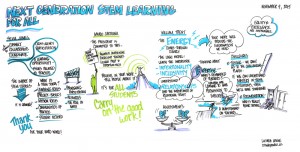
Mario Cardona, Senior Policy Advisor for Education at the White House Domestic Policy Council, made connections to the events planned for the remainder of the week, including the White House Summit on Next Generation High Schools, noting in particular the importance of research conducted through NSF funding and how it can inform the development and scaling of inclusive STEM high schools. Video:
William Trent closed the Forum by praising the energy of the day, and underlined the opportunity and obligation of attendees to continue to share insights and findings across stakeholder groups in order to bring next generation high schools to scale. Video:
*Graphic recordings use images and text to capture the main ideas of each session.

